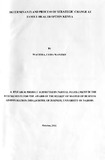| dc.description.abstract | In the business environment, there are many factors that drive and escalate the pace of change
within the organization. Staniforth (1996) asserts that the pressures on organizations to change
are many and the levers are numerous due to the environment that organizations operate in.
Pearce and Robinson (2000)identify political, economic, social, technological, and ecological
factors (PESTEL) as comprising the macro environment. This macro environment presents
organizations with opportunities, threats and constraints. Change process can be viewed as a one
off event, an exception to the normal running of an organization and therefore something to be
dealt on an issue by issue basis as it arises. On the other hand some organizations see change not
as an exception but as a norm, continuous process that forms part of the organizations day to day
activities.
Family health Options Kenya (FHOK) started experiencing problems in its operations,since the
onset of the 21st century.Major donors started pulling out one after another. Organization books
were characterized with long outstanding debts. Major suppliers started pulling out and the
existing ones were not willing to supply. Huge staff turnover was experienced and the remaining
staff went for months without salaries. As a result of the poor performance exhibited above, there
were several factors that compelled the top management of FHOK to make strategic changes so
that the organization could remain competitive and save its face. The study embarked on a
research of finding out what were these factors. The process of change is also another critical
element in change management. What process did FHOK employ in managing its change
program and was is it successful.
The two objectives for this study were to determine the factors that necessitated the strategic
changes that occurred at FHOK and the process through which change management was
employed. A case study research design was used in this study whereby interactive personal
interviews were carried out with four respondents who spearheaded most of the strategic change.
An interview guide with open ended questions was employed to gather primary data. Secondary
data was collected from the organization board minutes and Strategic plan.
The study found that both internal and external factors created the necessity for change at FHOK.
These included political interferences, technological upgrades, economic
effects, differing customer demands, the need for FHOK to salvage its image with its
stakeholders, the need to bring the organization back to sustainability, restructuring requirements
and the need to invest viably so as to generate higher income. It was further found that both the
continuous and one-off process was employed in the change process management.
Communication was used as a tool in whole change process. Employees were well empowered
with information way before the change took place and thus they had time to digest and evaluate
the change program before implementation and thus minimal or no resistance was experienced.
The researcher experienced a number of limitations in the study. The researcher was unable to
access all the information contained in the board minutes since they were availed only for a few
hours due to theirconfidentiality. The other limitation was the delay in collection of data since
the respondent demanded to be given more time to digest and evaluate the information being
collected by the interview guide.
This study on the determinants and process of change at FHOK could provide the basis for
carrying out future research in measuring the capacity for change and relating the effects of
change to performance of FHOK. Another suggestion for further research would be to access the
organization responsiveness to changes in the environment. | en |

